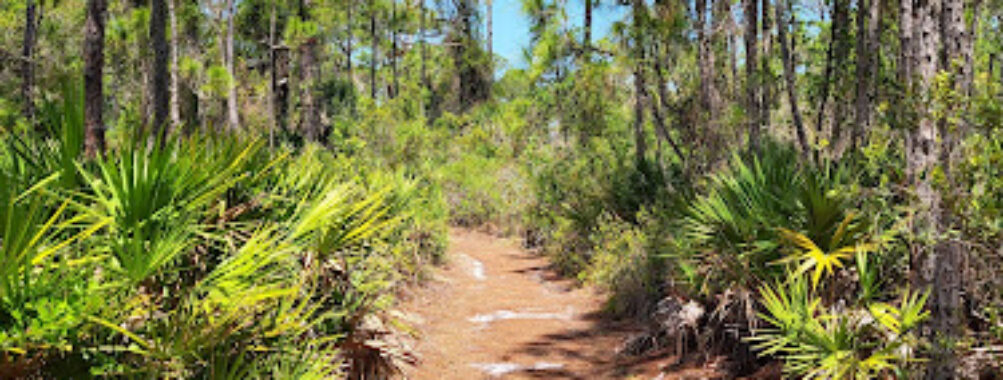
Cedar Point Environmental Park
Table of Contents
Description
Cedar Point Environmental Park is one of those places that quietly wins you over. It doesn’t scream for attention with flashy attractions or over-the-top gimmicks—rather, it invites you in with a calm, natural charm. The park stretches out with a mix of shady pine flatwoods, mangrove-lined waterways, and sandy trails that feel like they’ve been there forever. You can tell it’s been cared for, but it hasn’t been over-polished to the point of losing its wild side. That’s what makes it feel so real.
There’s a certain peacefulness here that’s hard to fake. You hear the crunch of your shoes on the trail, the rustle of palmettos in the breeze, and the occasional splash from a fish breaking the water’s surface. On a good day, you might spot an osprey circling overhead or a gopher tortoise slowly making its way across the path. It’s not a zoo, so wildlife sightings aren’t guaranteed, but that unpredictability is part of the fun.
It’s also a place that’s surprisingly accessible. The entrance and parking areas are wheelchair-friendly, and there are picnic tables and restrooms that make it easy to spend a whole afternoon here without having to rush off. I’ve come here with friends who aren’t big hikers, and they still enjoyed the shorter, kid-friendly loops. And yes, it’s a solid pick for families—kids can roam, explore, and actually learn a thing or two about Florida’s ecosystems without even realizing they’re learning.
That said, it’s not perfect. Some trails can get muddy after heavy rain, and mosquitoes have been known to crash the party in summer. But honestly, those are small trade-offs for the kind of quiet, unpretentious outdoor experience this park delivers. If you’re looking for a break from crowded beaches or noisy tourist strips, this is the kind of spot where you can just breathe for a while.
Key Features
- Multiple hiking trails, including short, kid-friendly loops and longer routes for more adventurous walkers
- Wheelchair-accessible entrance and parking
- Picnic tables in shaded areas
- Public restrooms for convenience
- Opportunities to spot local wildlife such as ospreys, gopher tortoises, and wading birds
- Peaceful mangrove and pine flatwood habitats
- Ideal for both solo visits and family outings
Best Time to Visit
If you ask me, the sweet spot for visiting Cedar Point Environmental Park is late fall through early spring. The weather is cooler, the air feels fresher, and—most importantly—the mosquitoes are far less aggressive. Mornings are especially nice, with soft light filtering through the trees and fewer people on the trails. Summer can still be beautiful here, but be prepared for heat, humidity, and the occasional afternoon thunderstorm. If you do go in the warmer months, an early start is your best friend.
Weekdays tend to be quieter, which makes it easier to feel like you have the place to yourself. I’ve come here on a Tuesday morning and barely crossed paths with another person, which is a rare gift in Florida’s busier coastal areas. On weekends, you’ll see more families and small groups, but it rarely feels overcrowded.
How to Get There
Reaching Cedar Point Environmental Park is straightforward if you’re already in the area. It’s located along the coast, not far from main roads, yet it feels pleasantly tucked away once you arrive. If you’re coming from a nearby city, you’ll likely take a scenic drive that passes through stretches of pine forest and coastal neighborhoods. There’s a clearly marked entrance, and parking is free. The lot is right by the trailheads, so you won’t have to haul your gear far before you’re surrounded by nature.
For travelers without a car, rideshare services or local taxis are an option, though having your own vehicle gives you the freedom to explore nearby spots before or after your visit. And if you’re the type who likes to bike, the ride here can be a pleasant one—just be mindful of traffic on certain stretches.
Tips for Visiting
First and foremost, bring water. Even on cooler days, the Florida sun has a way of sneaking up on you. Comfortable walking shoes are a must, especially if you plan to do more than the shortest loop. If you’re visiting in summer, bug spray is non-negotiable unless you enjoy being a mosquito buffet.
Photography lovers should pack a zoom lens—you never know when a bird of prey might swoop into view. And don’t forget binoculars if birdwatching is your thing. Families with kids might want to bring a small field guide or nature scavenger hunt list to keep little ones engaged along the way.
One thing I’ve learned from experience: check the weather before you go. Trails can get muddy after rain, and while that’s not a deal-breaker, it’s better to dress accordingly. Finally, take your time. This isn’t the kind of park you rush through—it’s best enjoyed at a slower pace, letting the details sink in. You might just find that the slower you move, the more you see.
Location
Places to Stay Near Cedar Point Environmental Park
Find and Book a Tour
Explore More Travel Guides
No reviews found! Be the first to review!